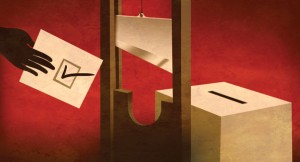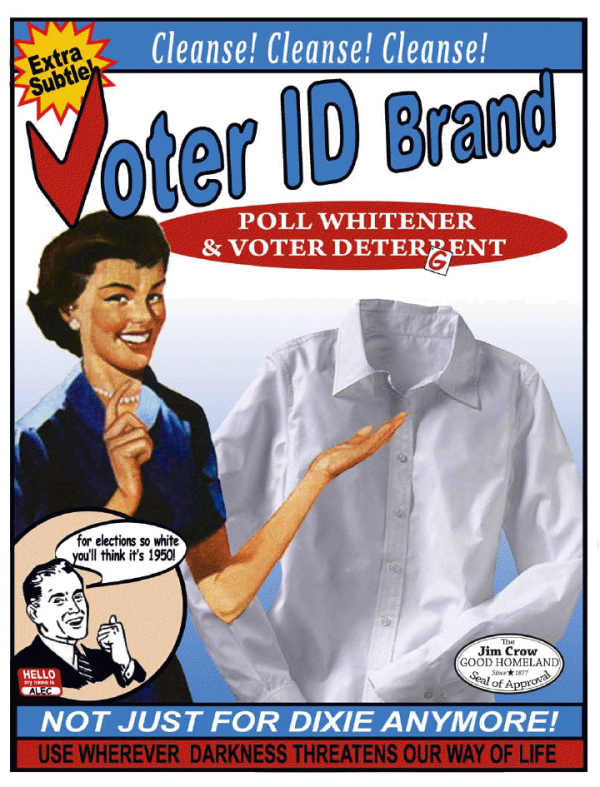INQUIRER: More than 758,000 registered voters in Pennsylvania do not have photo identification cards from the state Transportation Department, putting their voting rights at risk in the November election, according to data released Tuesday by state election officials. The figures – representing 9.2 percent of the state’s 8.2 million voters – are significantly higher than prior estimates by the Corbett administration. Secretary of the Commonwealth Carol Aichele has repeatedly said that 99 percent of Pennsylvania’s voters already had the photo ID they will need at the polls in November. The new numbers, based on a comparison of voter registration rolls with PennDot ID databases, shows the potential problem is much bigger, particularly in Philadelphia, where 186,830 registered voters – 18 percent of the city’s total registration – do not have PennDot ID.![]()
Under Pennsylvania’s new voter ID law, various other forms of photo identification will be accepted at voting places in November, including U.S. passports, student identification cards with expiration dates, current military  identification, and ID cards issued to government employees. But for most voters, the Pennsylvania driver’s license is the standard photo ID. The disclosure that 9 percent of the state’s registered voters don’t have one – or an alternative, nondriver PennDot photo ID – provides a clearer picture of the hurdle set up by the state’s new voter ID requirement. Republican lawmakers pushed the bill through the legislature in March and it was signed into law by Gov. Corbett, over protests from Democrats that the measure would disenfranchise thousands of voters, disproportionately affecting those without driver’s licenses – the poor, the elderly, and the young. House Republican leader Mike Turzai acknowledged the law’s political implications at a Republican State Committee meeting last month. “Voter ID – which is going to allow Gov. Romney to win the state of Pennsylvania – done,” Turzai told the crowd, which burst into applause, as he listed legislative accomplishments under GOP control. MORE
identification, and ID cards issued to government employees. But for most voters, the Pennsylvania driver’s license is the standard photo ID. The disclosure that 9 percent of the state’s registered voters don’t have one – or an alternative, nondriver PennDot photo ID – provides a clearer picture of the hurdle set up by the state’s new voter ID requirement. Republican lawmakers pushed the bill through the legislature in March and it was signed into law by Gov. Corbett, over protests from Democrats that the measure would disenfranchise thousands of voters, disproportionately affecting those without driver’s licenses – the poor, the elderly, and the young. House Republican leader Mike Turzai acknowledged the law’s political implications at a Republican State Committee meeting last month. “Voter ID – which is going to allow Gov. Romney to win the state of Pennsylvania – done,” Turzai told the crowd, which burst into applause, as he listed legislative accomplishments under GOP control. MORE
RELATED: In the past, states had accepted a variety of documents, such as utility bills and bank statements, to verify that a voter was who he said he was. But in ’05, Republicans in Indiana pushed through a law to change all that. It called, for the first time, for photo ID only, no exceptions. Democrats opposed the bill, arguing that it was just a cynical effort to make it harder for people with no picture ID—often the young, the poor, and the nonwhite—to vote. The bill passed nonetheless, on a party-line vote. Then it was challenged in court, and three years later, in Crawford v. Marion County Election Board, the US Supreme Court handed down a key decision upholding the photo ID requirement. Sure, wrote Justice John Paul Stevens for the majority, the law might have been motivated in part by Republican “partisan interest.” But so long as its goals were supported by “valid neutral justifications,” it was constitutional. With that, the floodgates opened. According to the National Conference of State Legislatures, 16 states have now passed photo ID laws, and bills are pending in 11 more. MORE
RELATED: Republicans have long tried to drive Democratic voters away from the polls. “I don’t want everybody to vote,” the influential conservative activist Paul Weyrich told a gathering of evangelical leaders in 1980. “As a matter  of fact, our leverage in the elections quite candidly goes up as the voting populace goes down.” But since the 2010 election, thanks to a conservative advocacy group founded by Weyrich, the GOP’s effort to disrupt voting rights has been more widespread and effective than ever. In a systematic campaign orchestrated by the American Legislative Exchange Council – and funded in part by David and Charles Koch, the billionaire brothers who bankrolled the Tea Party – 38 states introduced legislation this year designed to impede voters at every step of the electoral process. MORE
of fact, our leverage in the elections quite candidly goes up as the voting populace goes down.” But since the 2010 election, thanks to a conservative advocacy group founded by Weyrich, the GOP’s effort to disrupt voting rights has been more widespread and effective than ever. In a systematic campaign orchestrated by the American Legislative Exchange Council – and funded in part by David and Charles Koch, the billionaire brothers who bankrolled the Tea Party – 38 states introduced legislation this year designed to impede voters at every step of the electoral process. MORE
RELATED: Multiple studies taking different approaches have all come to the same conclusion: The rate of voter fraud in American elections is close to zero. In her 2010 book, The Myth of Voter Fraud, Lorraine Minnite tracked down every single case brought by the Justice Department between 1996 and 2005 and found that the number of defendants had increased by roughly 1,000 percent under Ashcroft. But that only represents an increase from about six defendants per year to 60, and only a fraction of those were ever convicted of anything. A New York Times investigation in 2007 concluded that only 86 people had been convicted of voter fraud during the previous five years. Many of those appear to have simply made mistakes on registration forms or misunderstood eligibility rules, and more than 30 of the rest were penny-ante vote-buying schemes in local races for judge or sheriff. The investigation found virtually no evidence of any organized efforts to skew elections at the federal level. Another set of studies has examined the claims of activist groups like Thor Hearne’s American Center for Voting Rights, which released a report in 2005 citing more than 100 cases involving nearly 300,000 allegedly fraudulent votes during the 2004 election cycle. The charges involved sensational-sounding allegations of double-voting, fraudulent addresses, and voting by felons and noncitizens. But in virtually every case they dissolved upon investigation. Some of them were just flatly false, and others were the result of clerical errors. Minnite painstakingly investigated each of the center’s charges individually and found only 185 votes that were even potentially fraudulent. The Brennan Center for Justice at New York University has focused on voter fraud issues for years. In a 2007 report they concluded that “by any measure, voter fraud is extraordinarily rare.” In the Missouri election of 2000 that got Sen. Bond so worked up, the Center found a grand total of four cases of people voting twice, out of more than 2 million ballots cast. In the end, the verified fraud rate was 0.0003 percent. MORE
RELATED: None of the requirements for a photo ID will be impossible to meet, but it will make voting inconvenient. While the Republicans aren’t erecting literal barriers to voting, they can’t say with a straight face that they aren’t  introducing an element of unprecedented Election Day hassle. That is the point. In a nation already cursed with low turnouts, there is a fiendish elegance to voter ID laws. It’s a tactic exclusively designed to reduce the number of Democratic voters, who will be discouraged by long lines in their precincts caused by the new screening procedures. MORE
introducing an element of unprecedented Election Day hassle. That is the point. In a nation already cursed with low turnouts, there is a fiendish elegance to voter ID laws. It’s a tactic exclusively designed to reduce the number of Democratic voters, who will be discouraged by long lines in their precincts caused by the new screening procedures. MORE
PHILLY POST: Gov. Corbett and his allies aren’t just trying to inconvenience a few Democrats on Election Day. They’re trying to keep Philadelphia itself from making a difference in the state’s politics. In retrospect, it should’ve been obvious. Take a look, after all, at the people who are eligible to vote under the state’s new law:
- Anybody with a driver’s license, or a more generic state-issued photo ID
- Anybody with a photo ID identifying them as an employee of local, state, or federal government.
- Anybody with a college photo ID
- Anybody with a military photo ID
- And anybody with a photo ID identifying them as a resident of a state nursing home.
Notice who that leaves out? The urban poor. And where’s the biggest concentration of urban poor in the state of Pennsylvania? Philadelphia. Let’s clarify: If you’re poor in Philadelphia, there’s a good chance you’ve never needed a driver’s license. (Cars are expensive to maintain and park; and there’s a functioning public transit system here.) There’s a good chance you’ve never been to college. There’s a good chance, generally, that you’ve never needed to obtain any of the types of identification needed to vote. And no, those same rules don’t apply to poor people in the rural parts of Pennsylvania. There is no SEPTA service in the nether regions of the state: Everybody, rich and poor, needs a  car to get around. That means they need those licenses. On the flip side, there’s plenty of middle-class Philadelphians who grew up never getting behind the wheel of a car. But among the younger generations, at least, most of them have been to college. So they’re covered. Which means, ultimately, that the law could not have been more perfectly crafted to keep Philadelphia—and its huge population of impoverished city-dwellers—from making a difference in the state’s elections. That’s pretty much what has happened: The 18 percent of city voters who might be ineligible to vote doubles the statewide average. The question is: Does anybody really believe that’s a coincidence? A quirk of fate? A mere byproduct of a well-intentioned process? MORE
car to get around. That means they need those licenses. On the flip side, there’s plenty of middle-class Philadelphians who grew up never getting behind the wheel of a car. But among the younger generations, at least, most of them have been to college. So they’re covered. Which means, ultimately, that the law could not have been more perfectly crafted to keep Philadelphia—and its huge population of impoverished city-dwellers—from making a difference in the state’s elections. That’s pretty much what has happened: The 18 percent of city voters who might be ineligible to vote doubles the statewide average. The question is: Does anybody really believe that’s a coincidence? A quirk of fate? A mere byproduct of a well-intentioned process? MORE
NUMBER OF PENNSYLVANIANS THAT MAY NOT BE ABLE TO VOTE ON NOVEMBER 4th BECAUSE OF VOTER ID LAW PASSED BY GOVERNOR TOM CORBETT TO COMBAT VOTER FRAUD : 758,000
NUMBER OF VOTER FRAUD CASES PROSECUTED BY ATTORNEY GENERAL TOM CORBETT: 0


